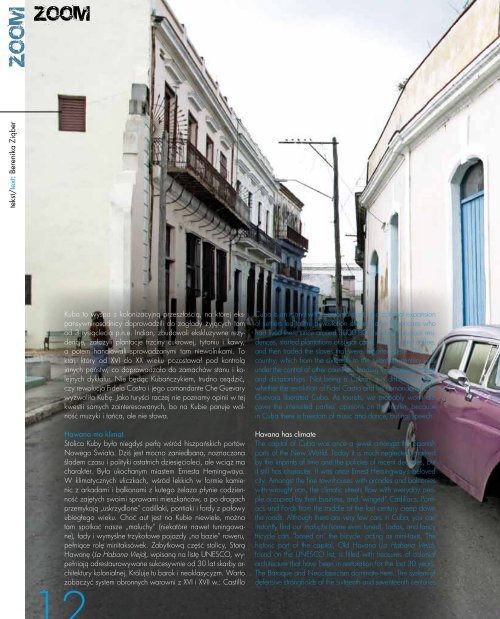Create successful ePaper yourself
Turn your PDF publications into a flip-book with our unique Google optimized e-Paper software.
tekst/text: Berenika Ziąber<br />
Kuba to wyspa z kolonizacyjną przeszłością, na której ekspansywni<br />
osadnicy doprowadzili do zagłady żyjących tam<br />
od 3 tysiąclecia p.n.e. Indian, zbudowali ekskluzywne rezydencje,<br />
założyli plantacje trzciny cukrowej, tytoniu i kawy,<br />
a potem handlowali sprowadzanymi tam niewolnikami. To<br />
kraj, który od XVI do XX wieku pozostawał pod kontrolą<br />
innych państw, co doprowadzało do zamachów stanu i kolejnych<br />
dyktatur. Nie będąc Kubańczykiem, trudno osądzić,<br />
czy rewolucja Fidela Castro i jego comandante Che Guevary<br />
wyzwoliła Kubę. Jako turyści raczej nie poznamy opinii w tej<br />
kwestii samych zainteresowanych, bo na Kubie panuje wolność<br />
muzyki i tańca, ale nie słowa.<br />
Hawana ma klimat<br />
Stolica Kuby była niegdyś perłą wśród hiszpańskich portów<br />
Nowego Świata. Dziś jest mocno zaniedbana, naznaczona<br />
śladem czasu i polityki ostatnich dziesięcioleci, ale wciąż ma<br />
charakter. Była ukochanym miastem Ernesta Hemingwaya.<br />
W klimatycznych uliczkach, wśród lekkich w formie kamienic<br />
z arkadami i balkonami z kutego żelaza płynie codzienność<br />
zajętych swoimi sprawami mieszkańców, a po drogach<br />
przemykają „uskrzydlone” cadillaki, pontiaki i fordy z połowy<br />
ubiegłego wieku. Choć aut jest na Kubie niewiele, można<br />
tam spotkać nasze „maluchy” (niekatóre nawet tuningowane),<br />
łady i wymyślne trzykołowe pojazdy „na bazie” roweru,<br />
pełniące rolę minitaksówek. Zabytkową część stolicy, Starą<br />
Hawanę (La Habana Vieja), wpisaną na listę UNESCO, wypełniają<br />
odrestaurowywane sukcesywnie od <strong>30</strong> lat skarby architektury<br />
kolonialnej. Króluje tu barok i neoklasycyzm. Warto<br />
zobaczyć system obronnych warowni z XVI i XVII w.: Castillo<br />
Cuba is an island with a colonial past, and colonial expansion<br />
of settlers led to the devastation of the Native Americans who<br />
had lived there since around <strong>30</strong>00 BC; they built luxurious residences,<br />
started plantations of sugar cane, tobacco and coffee,<br />
and then traded the slaves that were imported there. This is a<br />
country, which from the sixteenth to the twentieth century was<br />
under the control of other countries, leading to successive coups<br />
and dictatorships. Not being a Cuban, it is difficult to judge<br />
whether the revolution of Fidel Castro and his comandante Che<br />
Guevara liberated Cuba. As tourists, we probably won’t discover<br />
the interested parties’ opinions on the matter, because<br />
in Cuba there is freedom of music and dance, but not speech.<br />
Havana has climate<br />
The capital of Cuba was once a jewel amongst the Spanish<br />
ports of the New World. Today it is much neglected, marked<br />
by the imprints of time and the policies of recent decades, but<br />
it still has character. It was once Ernest Hemingway’s beloved<br />
city. Amongst the fine townhouses with arcades and balconies<br />
with wrought iron, the climatic streets flow with everyday people<br />
occupied by their business, and “winged” Cadillacs, Pontiacs<br />
and Fords from the middle of the last century creep down<br />
the roads. Although there are very few cars in Cuba, you can<br />
instantly find our maluchs (some even tuned), Ladas, and fancy<br />
tricycle cars “based on” the bicycle, acting as mini-taxis. The<br />
historic part of the capital, Old Havana (La Habana Vieja),<br />
found on the UNESCO list, is filled with treasures of colonial<br />
architecture that have been in restoration for the last <strong>30</strong> years.<br />
The Baroque and Neoclassicism dominate here. The system of<br />
defensive strongholds of the sixteenth and seventeenth centuries


